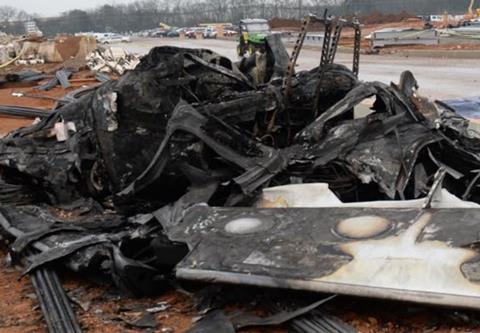US investigators believe wake turbulence from a landing Airbus A320 caused a trailing Cirrus SR22 to suffer a fatal in-flight upset on approach to Knoxville’s McGhee Tyson airport.
The SR22, with two occupants, had taken off from runway 23L on 16 December 2021, initially flying a left-hand circuit and practice approach to 23L before being instructed to enter a right-hand circuit for the same runway.
Its pilot testified to the inquiry that he was learning how to use a head-up display during the flight.
While flying downwind on the right-hand circuit the pilot was advised that an Allegiant Air A320 was on 3nm final approach to 23L.
The SR22 was instructed to extend its downwind leg before being told to follow the A320, but the National Transportation Safety Board, in its newly-issued final report, found that a cautionary wake-turbulence advisory was not issued.
It states that the SR22 turned onto the base leg about 1.8nm behind the Airbus.
According to the pilot’s testimony, the spacing from the Airbus “did not feel unusual or too close” compared with his previous experiences with landing behind heavy aircraft.
But after the SR22 was established on final approach, the crew felt a bump from wake turbulence.

Recorded information from the aircraft’s primary flight display indicates that, at about 1,000ft altitude, the SR22 sharply rolled 120° left and pitched some 30° nose-down.
While applying instinctive corrective inputs to the flight controls, the pilot urged the other occupant to activate the CAPS – the Cirrus Airframe Parachute System – which fires a rocket to deploy a parachute, allowing the aircraft to be brought slowly to the ground.
Although the pilot testified that he heard the rocket, and felt an initial deceleration from the parachute, the aircraft struck the ground and immediately caught fire.
The radar target for the aircraft had disappeared at around 1.5nm final for 23L.
Surveillance cameras at a construction site captured the SR22 (N162AM) descending rapidly, with the parachute starting to deploy moments before impact.
While the SR22’s pilot survived the crash, its other occupant succumbed to injuries.
Investigators state that the roll upset – which occurred at a height insufficient for recovery – was caused by the preceding aircraft’s wake vortex, and that air traffic control’s failure to issue a wake advisory contributed to the accident.


























